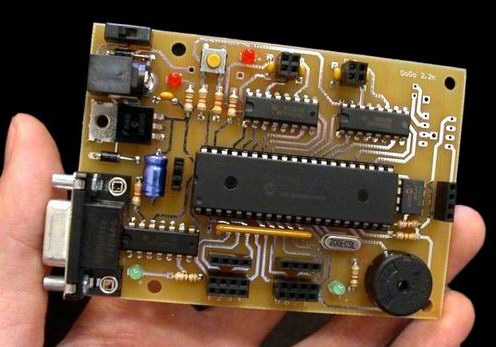 |
Overview |
Info/Download |
Documentation |
Sample Projects
Making a GoGo board | Board Variations | Links | FAQ |
|
IntroductionThe GoGo board is a simple and low-cost computer I/O interface device. Inspired by the Cricket and the IRX board, also developed at the MIT Media Lab, the GoGo board is useful for projects that need a simple interface between the computer and sensors (e.g. contact activated switches, light, and temperature sensors) and simple actuators (e.g. motors, relays, and LEDs). Possible applications include interactive art, sculptures, storytelling projects; game design; environmental sensing; and home automation. See project examples. There are software libraries available for a few programming languages. But in general, any language that has access to the serial port can utilize to the GoGo board. The GoGo board now also supports Cricket Logo (version 2) which allows it to store procedures in its memory and run them autonomously without being connected to a computer. This addition to the original tethered mode significantly broadens the applications of the board. Please see the Cricket and the Handy Cricket websites for more information about the autonomous mode. There are many version of the GoGo board. The term GoGo board, thus, refers to all the boards. Most of the boards are compatible with each other (e.g. can be controlled with the same software). For more information about how to use the GoGo board, please visit the getting started guide in the documentation page. You can make a GoGo boardThe GoGo board is a research project. So, it is not available as a commercial product. However, one of our design goals is to make it as easy as possible for non-experts to build the board. A framework is being developed to make the board as low-cost as possible both in terms of the electronic components and the necessary software environments. One GoGo board should cost less than $40. See making a GoGo board.
GoGo board and the MIT CricketFor those who are familiar with the MIT Cricket, the are similarities with the GoGo board especially in the hardware design, as many of the Cricket designers (especially Fred Martin) have kindly gave us many advices. Version 2 of the GoGo board supports the Cricket's programming language and software environments. The GoGo board is different from the Cricket in the sense that it is designed to be open source, low-cost, and easy for people to build.
GoGo board and the MIT IRXThe GoGo board was also inspired by the IRX. However, the IRX is designed more for engineers than other non-technical people. That is you need more technical background about electronics and programming to begin using the IRX. You need to know how to program a micro-controller, build your hardware interface to sensors, and write the serial interface code. | |
